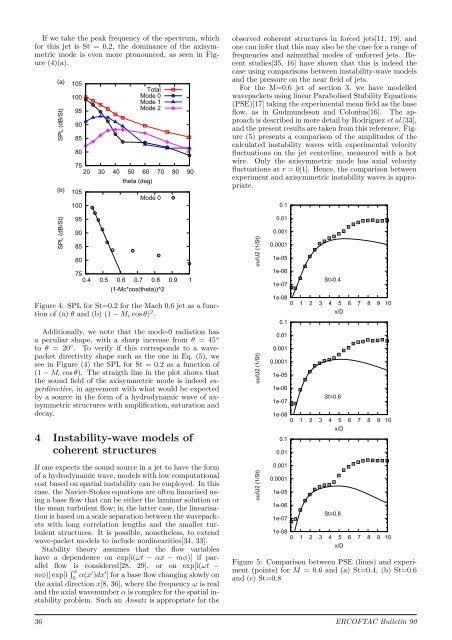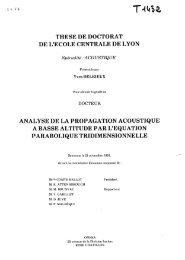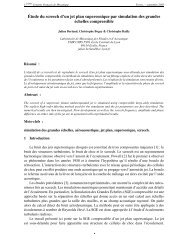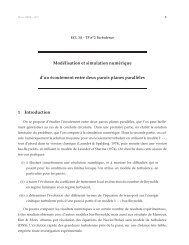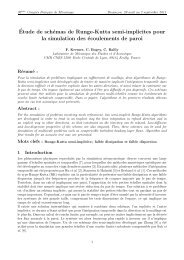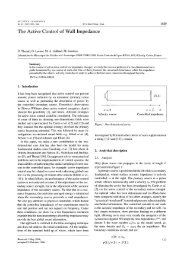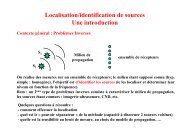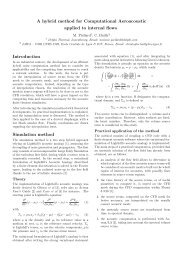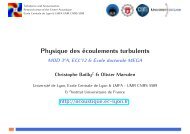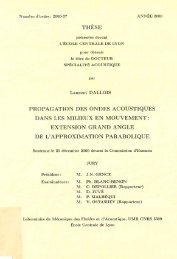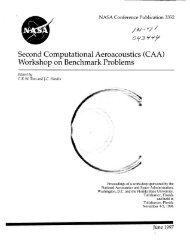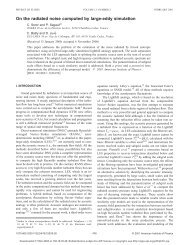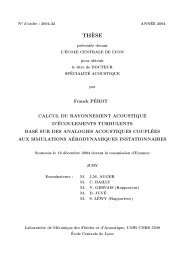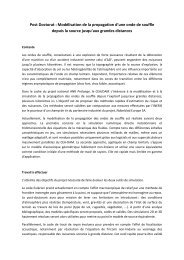ERCOFTAC Bulletin - Centre Acoustique
ERCOFTAC Bulletin - Centre Acoustique
ERCOFTAC Bulletin - Centre Acoustique
You also want an ePaper? Increase the reach of your titles
YUMPU automatically turns print PDFs into web optimized ePapers that Google loves.
If we take the peak frequency of the spectrum, which<br />
for this jet is St = 0.2, the dominance of the axisymmetric<br />
mode is even more pronounced, as seen in Figure<br />
(4)(a).<br />
(a)<br />
SPL (dB/St)<br />
(b)<br />
SPL (dB/St)<br />
105<br />
100<br />
95<br />
90<br />
85<br />
80<br />
Total<br />
Mode 0<br />
Mode 1<br />
Mode 2<br />
75<br />
20 30 40 50 60 70 80 90<br />
105<br />
100<br />
95<br />
90<br />
85<br />
80<br />
theta (deg)<br />
Mode 0<br />
75<br />
0.4 0.5 0.6 0.7 0.8 0.9 1<br />
(1-Mc*cos(theta))^2<br />
Figure 4: SPL for St=0.2 for the Mach 0.6 jet as a function<br />
of (a) θ and (b) (1 − Mc cos θ) 2 .<br />
Additionally, we note that the mode-0 radiation has<br />
a peculiar shape, with a sharp increase from θ = 45 ◦<br />
to θ = 20 ◦ . To verify if this corresponds to a wavepacket<br />
directivity shape such as the one in Eq. (5), we<br />
see in Figure (4) the SPL for St = 0.2 as a function of<br />
(1 − Mc cos θ). The straigth line in the plot shows that<br />
the sound field of the axisymmetric mode is indeed superdirective,<br />
in agreement with what would be expected<br />
by a source in the form of a hydrodynamic wave of axisymmetric<br />
structures with amplification, saturation and<br />
decay.<br />
4 Instability-wave models of<br />
coherent structures<br />
If one expects the sound source in a jet to have the form<br />
of a hydrodynamic wave, models with low computational<br />
cost based on spatial instability can be employed. In this<br />
case, the Navier-Stokes equations are often linearised using<br />
a base flow that can be either the laminar solution or<br />
the mean turbulent flow; in the latter case, the linearisation<br />
is based on a scale separation between the wavepackets<br />
with long correlation lengths and the smaller turbulent<br />
structures. It is possible, nonetheless, to extend<br />
wave-packet models to include nonlinearities[34, 33].<br />
Stability theory assumes that the flow variables<br />
have a dependence on exp[i(ωt − αx − mφ)] if parallel<br />
flow is considered[28, 29], or on exp[i(ωt −<br />
mφ)] exp[i x<br />
0 α(x′ )dx ′ ] for a base flow changing slowly on<br />
the axial direction x[8, 36], where the frequency ω is real<br />
and the axial wavenumber α is complex for the spatial instability<br />
problem. Such an Ansatz is appropriate for the<br />
observed coherent structures in forced jets[11, 19], and<br />
one can infer that this may also be the case for a range of<br />
frequencies and azimuthal modes of unforced jets. Recent<br />
studies[35, 16] have shown that this is indeed the<br />
case using comparisons between instability-wave models<br />
and the pressure on the near field of jets.<br />
For the M=0.6 jet of section 3, we have modelled<br />
wavepackets using linear Parabolised Stability Equations<br />
(PSE)[17] taking the experimental mean field as the base<br />
flow, as in Gudmundsson and Colonius[16]. The approach<br />
is described in more detail by Rodriguez et al.[33],<br />
and the present results are taken from this reference. Figure<br />
(5) presents a comparison of the amplitudes of the<br />
calculated instability waves with experimental velocity<br />
fluctuations on the jet centerline, measured with a hot<br />
wire. Only the axisymmetric mode has axial velocity<br />
fluctuations at r = 0[1]. Hence, the comparison between<br />
experiment and axisymmetric instability waves is appropriate.<br />
uu/U2 (1/St)<br />
uu/U2 (1/St)<br />
uu/U2 (1/St)<br />
0.1<br />
0.01<br />
0.001<br />
0.0001<br />
1e-05<br />
1e-06<br />
1e-07<br />
St=0.4<br />
1e-08<br />
0 1 2 3 4 5 6 7 8 9 10<br />
0.1<br />
0.01<br />
0.001<br />
0.0001<br />
1e-05<br />
1e-06<br />
1e-07<br />
x/D<br />
St=0.6<br />
1e-08<br />
0 1 2 3 4 5 6 7 8 9 10<br />
0.1<br />
0.01<br />
0.001<br />
0.0001<br />
1e-05<br />
1e-06<br />
1e-07<br />
x/D<br />
St=0.8<br />
1e-08<br />
0 1 2 3 4 5 6 7 8 9 10<br />
Figure 5: Comparison between PSE (lines) and experiment<br />
(points) for M = 0.6 and (a) St=0.4, (b) St=0.6<br />
and (c) St=0.8<br />
36 <strong>ERCOFTAC</strong> <strong>Bulletin</strong> 90<br />
x/D


